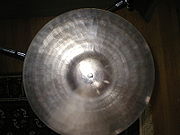
Zanchi
Encyclopedia

Italy
Italy , officially the Italian Republic languages]] under the European Charter for Regional or Minority Languages. In each of these, Italy's official name is as follows:;;;;;;;;), is a unitary parliamentary republic in South-Central Europe. To the north it borders France, Switzerland, Austria and...
brand of cymbal
Cymbal
Cymbals are a common percussion instrument. Cymbals consist of thin, normally round plates of various alloys; see cymbal making for a discussion of their manufacture. The greater majority of cymbals are of indefinite pitch, although small disc-shaped cymbals based on ancient designs sound a...
s. The brand was made between 1947 till around the mid 1990's, and was noted for its 'Vibra' cymbals.
History
Italian cymbal-maker, Fiorello Zanchi, reputedly started out working for the Tronci family of cymbal/pipe organ makers in the 1920s, according to Pinksterboer. Per the same source, it is said that Fiorello started his own workshop, Zanchi, in 1947, and began producing handmade, hand-hammered cymbals. However, to date none of these pre-50s Zanchis have shown themselves on the market (see below). Zanchi cymbals were marketed primarily in EuropeEurope
Europe is, by convention, one of the world's seven continents. Comprising the westernmost peninsula of Eurasia, Europe is generally 'divided' from Asia to its east by the watershed divides of the Ural and Caucasus Mountains, the Ural River, the Caspian and Black Seas, and the waterways connecting...
.
Some of their earlier series included the "Vibra Cymbals" line; for a number of years, Vibras were believed to have been produced in the 60s or 70s. Recent information provided by an owner of some hi-hats in Connecticut confirms that his were purchased in 1958, so this is the oldest attribution anyone has contributed thus far. A few F & F Vibra cymbals have appeared on the market which also show the "Revere" embossment: interesting because Revere was an early stencil brand of Pearl, Japan in the 60s, so one may presume that, for some period of time, Zanchi had a business relationship with Pearl. Vibras were B20 Alloy, usually thin, and are described by some as trashy sounding. Yet, their sizzle and iciness are considered by some musicians to be unique, even by today's standards.
Change of Name
In the 70s, the company name was changed to Zanki, perhaps because the Italian "ch" is pronounced as a "k"; or, perhaps, simply as a marketing device. During the 70s, Zankis usually had large ink logos with the 'Zanki' name. Sometimes the character font was hollow, sometimes bold. The embossed stamp was changed to read "ZANKI Italy". These cymbals were still handmade, but were heavier, and more conventional-sounding, and are considered by some to be comparable to a late 60s or early 70s Avedis Zildjian cymbal. Zanki occasionally still used the name Vibra on some of their 70s series cymbals, but they do not resemble the F & F Vibras from earlier, in either hammering or lathing.Manufacturing
Perhaps Fiorello Zanchi's biggest contribution to cymbal-making history was his development of the "rotocasting" technique, in which molten bronzeBronze
Bronze is a metal alloy consisting primarily of copper, usually with tin as the main additive. It is hard and brittle, and it was particularly significant in antiquity, so much so that the Bronze Age was named after the metal...
is poured into a cymbal cast that is mounted on a centrifuge
Centrifuge
A centrifuge is a piece of equipment, generally driven by an electric motor , that puts an object in rotation around a fixed axis, applying a force perpendicular to the axis...
, and rotated as the liquefied metal is being cooled inside the cast. This new technique created a brand new sound in Italian cymbals, much brighter than the previous Zankis. It is reputed that Fiorello used the larger workshop at UFIP to do his rotocasting. These rotocast cymbals bore a new embossed stamp, "Zanki Rotocasting". Some of these cymbals also show an additional embossment that reads: "Music Industries". Still others show an ink stamp by the Italian distributor "Mario Corso". It would appear from the varying stamps of this period that Zanki was associating with different distributors in an attempt to keep the cymbals on the market.
Closure and Influence
According to Pinkstoerber, Fiorello Zanchi died in the 80s and his sons, Mariano and Roni, continued the company. Ultimately, however, at some point in the late 80s or early 90s, F & F Zanki (like many other small, independent cymbal/gong-making families in Italy at the time, including Tronci and Tuscano) could no longer compete with the larger cymbal-makers. Amid concern that the Italian tradition of cymbal-making was at risk of becoming extinct, many of the smaller operations joined under the banner of the largest/oldest Italian union/workshop, UFIP, and ceased independent production. Thus, Fiorello and Sons brought to UFIP the technique of rotocasting, which is a UFIP trademark today.As F & F Zanki was more or less targeting the mid-price range of the market, some of its cymbals are considered to be mediocre at best, while others ranged from "exceptional" to "not too good at all". The varying quality of these remaining cymbals may well be why they remain relatively obscure. However, Zankis are significant in cymbal-making history and Fiorello Zanchi deserves his place on the list of notable cymbal artisans.
Their signature stamp reads: "F & F Zanchi, Made in Italy". "F & F" stands for "Fiorello e Figli" (Fiorello and Sons).

